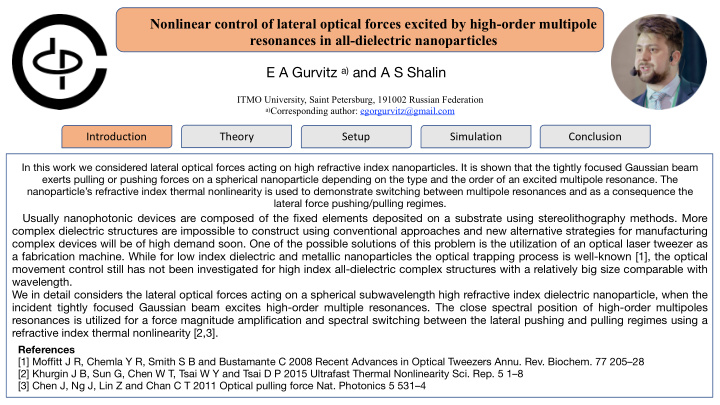



Nonlinear control of lateral optical forces excited by high-order multipole resonances in all-dielectric nanoparticles E A Gurvitz a) and A S Shalin ITMO University, Saint Petersburg, 191002 Russian Federation a) Corresponding author: egorgurvitz@gmail.com Introduction Theory Setup Simulation Conclusion In this work we considered lateral optical forces acting on high refractive index nanoparticles. It is shown that the tightly focused Gaussian beam exerts pulling or pushing forces on a spherical nanoparticle depending on the type and the order of an excited multipole resonance. The nanoparticle’s refractive index thermal nonlinearity is used to demonstrate switching between multipole resonances and as a consequence the lateral force pushing/pulling regimes. Usually nanophotonic devices are composed of the fixed elements deposited on a substrate using stereolithography methods. More complex dielectric structures are impossible to construct using conventional approaches and new alternative strategies for manufacturing complex devices will be of high demand soon. One of the possible solutions of this problem is the utilization of an optical laser tweezer as a fabrication machine. While for low index dielectric and metallic nanoparticles the optical trapping process is well-known [1], the optical movement control still has not been investigated for high index all-dielectric complex structures with a relatively big size comparable with wavelength. We in detail considers the lateral optical forces acting on a spherical subwavelength high refractive index dielectric nanoparticle, when the incident tightly focused Gaussian beam excites high-order multiple resonances. The close spectral position of high-order multipoles resonances is utilized for a force magnitude amplification and spectral switching between the lateral pushing and pulling regimes using a refractive index thermal nonlinearity [2,3]. References [1] Moffitt J R, Chemla Y R, Smith S B and Bustamante C 2008 Recent Advances in Optical Tweezers Annu. Rev. Biochem. 77 205–28 [2] Khurgin J B, Sun G, Chen W T, Tsai W Y and Tsai D P 2015 Ultrafast Thermal Nonlinearity Sci. Rep. 5 1–8 [3] Chen J, Ng J, Lin Z and Chan C T 2011 Optical pulling force Nat. Photonics 5 531–4
Nonlinear control of lateral optical forces excited by high-order multipole resonances in all-dielectric nanoparticles E A Gurvitz and A S Shalin Theory Setup Introduction Simulation Conclusion High order resonance in the sphere. Mie theory. Hot sphere Multipole decomposition of scattering cross- section for a spherical nanoparticle with refractive index (a) for the normal temperature (25 ° С ) and (b) for the refractive index changed by ~3% ( n =4.1) by the thermal nonlinearity (b). The absorption coe ffi cient in both cases is k =0.04. The indicators show the spectral positions of high order multipole resonance before and after the heating. For the normal temperature ( а ) size parameter ( k is a wave number of incident plane wave and r is a radius of the spherical particle) of the electric octupole resonance is and for magnetic octupole resonance correspondingly. When the particle is heated and refractive index is changed, multipole resonances are red shifted (for electric octupole resonance and for magnetic octupole resonance ). The spectral shift is larger than half-width of the resonance. For the particle with n=4 exited an electric quadrupole resonance at and at the system is not in a resonant state.
Nonlinear control of lateral optical forces excited by high-order multipole resonances in all-dielectric nanoparticles E A Gurvitz and A S Shalin Introduction Theory Setup Simulation Conclusion The scheme of the numerical simulation model. The scheme of the numerical simulation model (a) and normalized scattered electric field distribution near the air/substrate interface calculated in COMSOL Multiphysics (b). Gaussian beam waist fixed to 1um and 𝑙𝑠 = 1.377. The particle center and beam waist are situated at the origin of the coordinate frame. The white circle denotes the particle surface ( 𝑠 =120[nm]) over which the optical force is calculated.
Nonlinear control of lateral optical forces excited by high-order multipole resonances in all-dielectric nanoparticles E A Gurvitz and A S Shalin Theory Introduction Setup Simulation Conclusion Electric octupole Magnetic octupole/electric quadrupole Lateral and longitudinal components of optical force acting on nanoparticle (a,b) for 𝑙𝑠 = 1.653 (no resonance state for n=4 and resonance of electric octupole with n=4.1) and (c,d) for 𝑙𝑠 = 1.377 (resonance of electric quadrupole for n=4 and resonance of magnetic octupole for n=4.1). The particle size and beam waist in the calculation were taken 120[nm] and 1[um] correspondingly.
Nonlinear control of lateral optical forces excited by high-order multipole resonances in all-dielectric nanoparticles E A Gurvitz and A S Shalin ITMO University, Saint Petersburg, 191002 Russian Federation Simulation Conclusion Introduction Theory Setup 1. The two typical regimes (resonant/nonresonant and resonant/resonant) of the optical force for high refractive index particles are shown. 2. The switching effects between lateral pulling and pushing regimes were studied under the assumption of the constant particle size and the refractive index tuned by a heating stimuli. 3. Switching between nonresonant/resonant regimes allows an increase of the lateral optical force around 40% for the case when the electric octupole is dominantly excited. 4. Upon switching between the electric quadrupole and magnetic octupole resonance, the longitudinal optical force doubles and the lateral force changes direction. Corresponding author: egorgurvitz@gmail.com
Recommend
More recommend